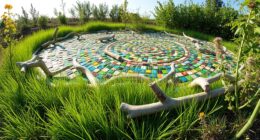Biophilic art helps you bring nature into your creative spaces, enhancing your environment with natural elements like plants, organic shapes, and nature-inspired colors. It boosts your well-being, sparks inspiration, and promotes a calming atmosphere that supports productivity. By incorporating natural textures and artwork inspired by the outdoors, you create a harmonious space that nurtures your imagination. To discover ways to seamlessly integrate biophilic design into your environment, explore further insights below.
Key Takeaways
- Biophilic art integrates natural elements and themes to create calming, inspiring environments that enhance well-being and creativity.
- It employs natural materials, organic shapes, and plant-based visuals to connect indoor spaces with nature.
- Incorporating living plants and DIY biophilic elements fosters a vibrant, health-promoting atmosphere in creative environments.
- Nature-inspired color palettes and large-scale murals evoke serenity and stimulate imaginative thinking.
- Future trends include immersive VR/AR experiences and AI-optimized plant installations to deepen the connection with nature.
Understanding the Principles of Biophilic Design
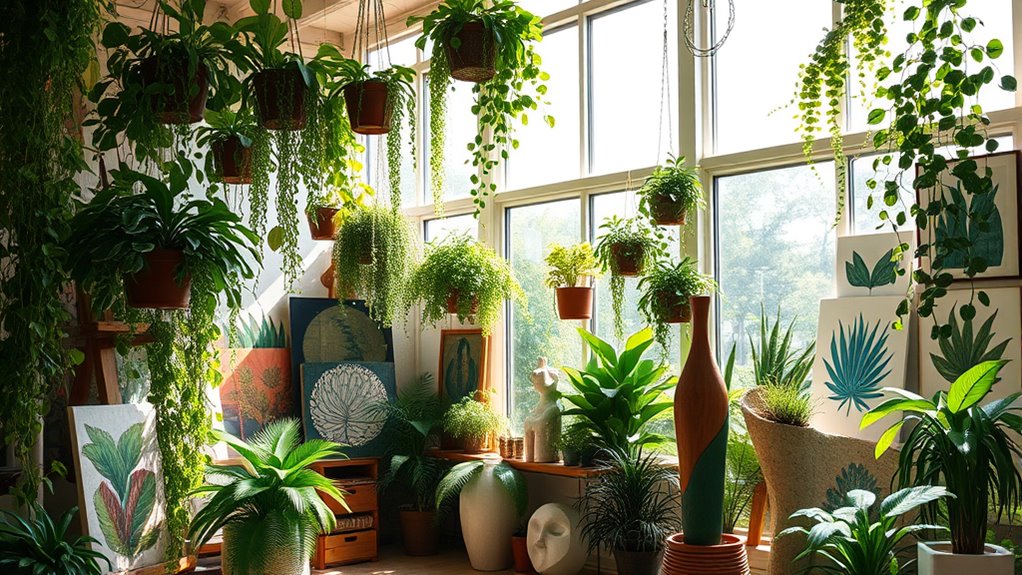
Understanding the principles of biophilic design begins with recognizing its goal: to connect people with nature within built environments. You aim to create spaces that foster well-being by integrating natural elements seamlessly. This approach emphasizes the importance of natural light, views of greenery, and organic shapes to evoke a sense of calm and familiarity. You focus on designing environments that encourage interaction with nature, whether through indoor plants, water features, or textures reminiscent of natural landscapes. By prioritizing these elements, you help cultivate spaces that feel alive and nurturing. Incorporating natural light and views of greenery can significantly enhance occupants’ emotional and physical health. The core idea is to blur the boundaries between indoors and outdoors, making nature an integral part of everyday life. This thoughtful integration enhances comfort, productivity, and overall health.
The Role of Natural Materials in Artistic Expression
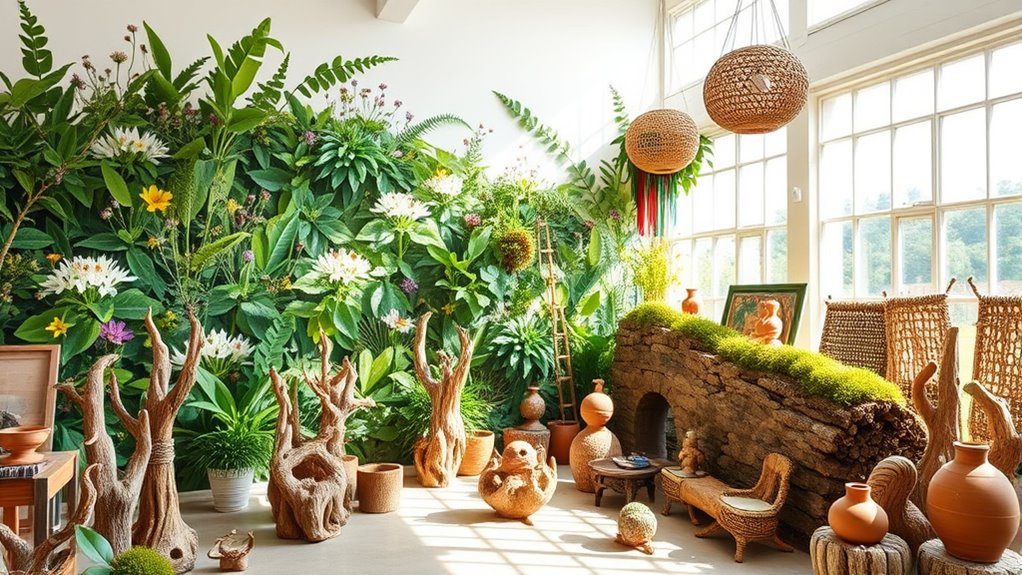
Natural materials bring a unique organic aesthetic to your artwork, emphasizing authenticity and connection to the environment. Using sustainable practices, you can create pieces that are both beautiful and environmentally responsible. Embracing these materials allows your art to reflect a deeper harmony with nature. Incorporating glycolic acid products into your skincare routine can enhance your overall well-being, complementing the natural approach of your artistic expression.
Organic Material Aesthetics
Organic materials bring a raw, tactile quality to art that instantly connects viewers with nature. They evoke authenticity, grounding your work in the natural world’s textures and imperfections. When you incorporate wood, stone, bamboo, or clay, you create a sense of warmth and familiarity that digital mediums can’t replicate. These materials invite touch and exploration, making your art more immersive. Their irregularities and natural grains add character and uniqueness to each piece, emphasizing organic beauty. Using these materials also encourages spontaneity, as their unpredictable qualities challenge your creative process. You might choose rough-hewn timber for a rustic sculpture or smooth river stones for a calming mosaic. This approach celebrates the inherent aesthetics of nature, emphasizing authenticity and sensory engagement. Incorporating material authenticity enhances the emotional impact and depth of your artistic expressions.
Sustainable Artistic Practices
Incorporating natural materials into your art practice promotes sustainability by reducing reliance on synthetic and non-renewable resources. When you choose materials like wood, clay, or plant fibers, you lower your environmental impact and support eco-friendly production. Natural materials often require less energy to produce and can be recycled or composted after use, minimizing waste. Using locally sourced materials also cuts transportation emissions. Embracing these resources encourages you to explore textures and forms rooted in nature, fostering a deeper connection to your environment. By prioritizing sustainable materials, you not only create visually compelling art but also promote ecological responsibility. Your choices influence the broader artistic community, inspiring others to adopt environmentally conscious practices that preserve natural resources for future generations. Additionally, selecting biodegradable materials ensures your artwork remains environmentally friendly throughout its lifecycle.
Incorporating Living Plants Into Creative Environments
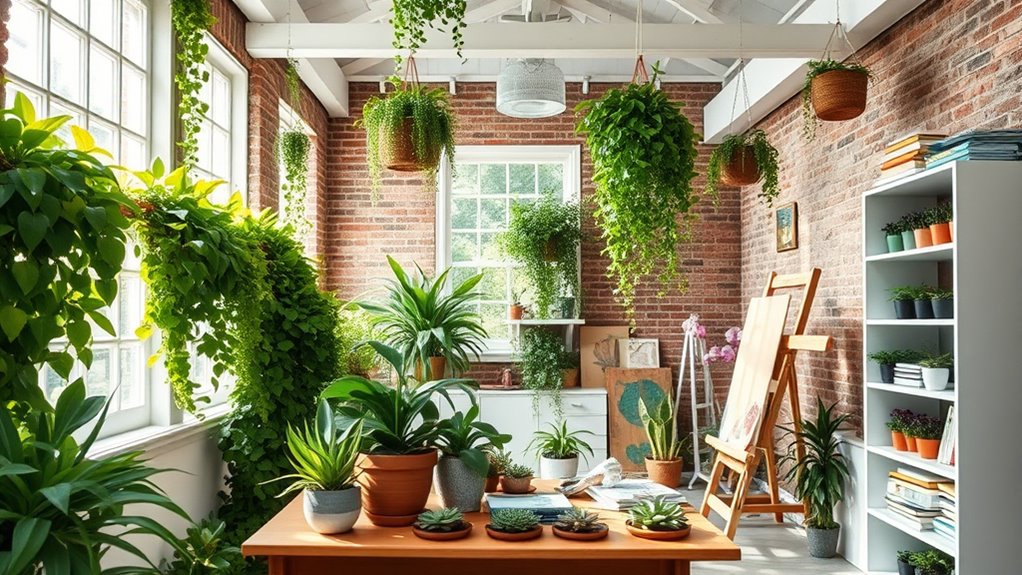
Adding living plants to creative environments instantly boosts their liveliness and aesthetic appeal. You can transform a dull space into a vibrant sanctuary by integrating greenery that complements your artistic vibe. Consider placing tall potted trees near windows to create a lush backdrop, or hanging planters with trailing vines for a relaxed, organic feel. Small succulents and cacti on desks bring a touch of nature without cluttering your workspace. Incorporate vertical gardens or wall-mounted planters to maximize space and add visual interest. These additions not only enhance your environment’s beauty but also improve air quality and create a calming atmosphere. With thoughtful placement, living plants become an inspiring, natural extension of your creative space, fostering inspiration and well-being.
Organic Shapes and Patterns in Artworks
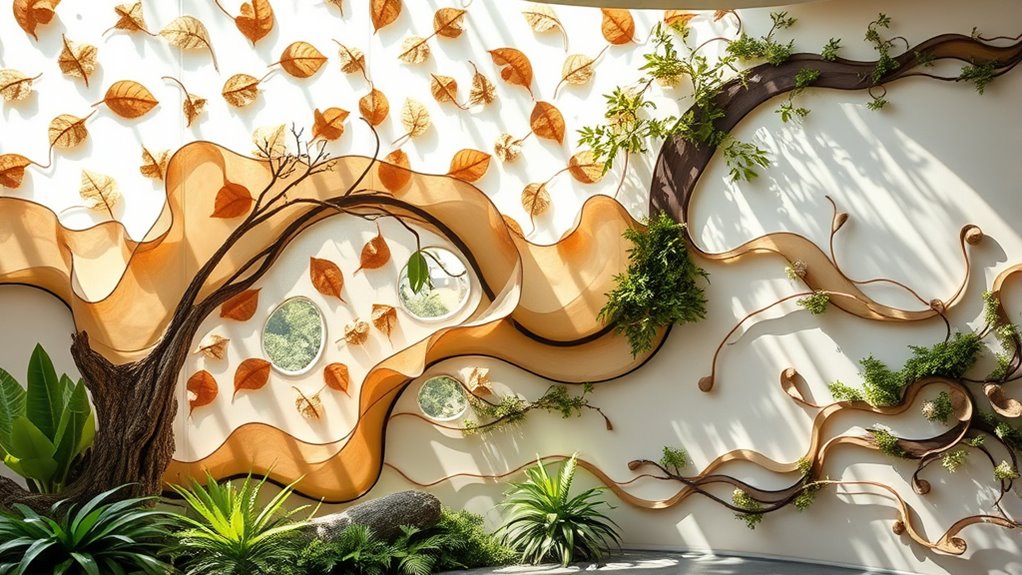
Living plants introduce natural forms into your environment, inspiring the use of flowing shapes and patterns in artwork. You’ll notice how organic shapes—curves, spirals, and irregular outlines—mirror nature’s fluidity. These patterns evoke a sense of harmony and movement, making your space feel more alive. Artists often incorporate motifs like leaf veins, waves, or biomorphic forms to create visual interest and connect viewers to the natural world. Using these shapes can soften harsh lines and add a sense of organic unpredictability. By integrating flowing, irregular patterns, your artwork becomes more dynamic and inviting. Emphasizing organic shapes helps establish a seamless relationship between nature and your creative space, fostering a calming atmosphere that celebrates the beauty of natural forms. Additionally, incorporating interior design principles can enhance the overall harmony between your artwork and environment.
The Psychological Benefits of Nature-Inspired Decor
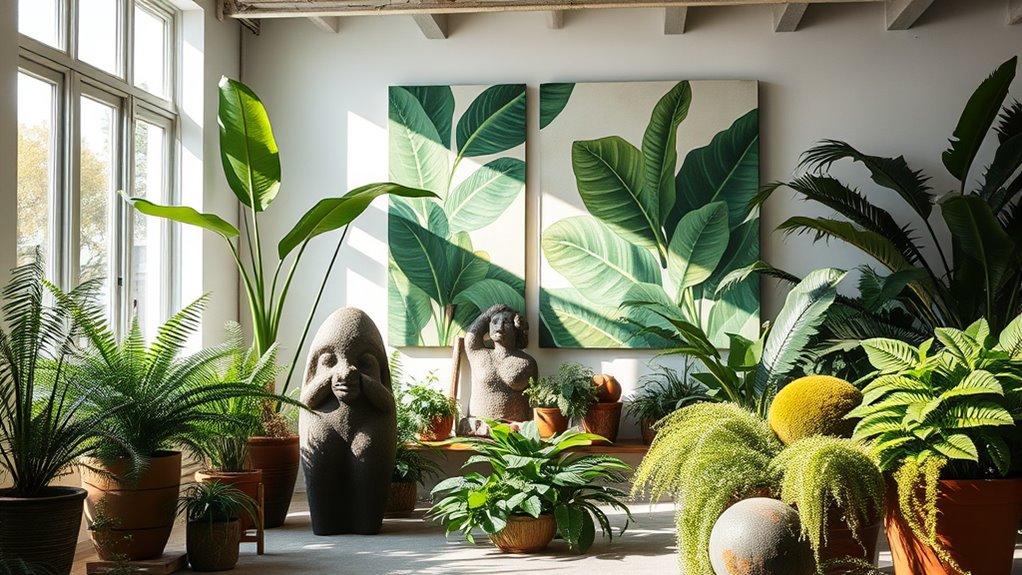
When you incorporate nature-inspired decor into your space, you may notice your stress levels decrease and your mood improve. These elements can also ignite your creativity, making it easier to generate new ideas. Embracing biophilic art creates a calming environment that boosts both mental well-being and inspiration. Additionally, integrating principles from the Law of Attraction can enhance your ability to attract positive energy and outcomes through your environment.
Stress Reduction Effects
Have you ever noticed how a view of greenery can instantly calm your mind? When you incorporate nature-inspired decor, your environment naturally reduces stress levels. This calming effect occurs because natural elements activate your parasympathetic nervous system, promoting relaxation. Visual cues like lush plants or earthy tones can lower cortisol levels and decrease feelings of anxiety. Imagine walking into a space filled with:
- Soft, organic colors that soothe your eyes
- Real or faux plants that add a sense of life
- Natural textures like wood or stone for tactile comfort
- Artwork depicting serene landscapes that evoke peace
Incorporating Wood and Stone materials further enhances the natural ambiance and supports your mental well-being. These elements work together to create a sanctuary where stress melts away. By surrounding yourself with nature-inspired decor, you foster a calming atmosphere that supports mental well-being and helps you unwind.
Enhanced Mood Boosting
Incorporating nature-inspired decor can markedly elevate your mood and foster a sense of well-being. When you surround yourself with elements like lush greenery, calming images of natural landscapes, or earthy tones, you create an environment that naturally uplifts your spirits. These visuals and textures activate positive emotional responses, helping you feel more relaxed and content. Nature-inspired decor reduces feelings of anxiety and promotes feelings of happiness and tranquility. The presence of natural elements can also trigger the release of endorphins, boosting your overall mood. As you integrate these touches into your space, you’ll notice a more optimistic outlook and increased emotional resilience. Creating environments rich in biodiversity can further enhance these psychological benefits, making your space not only beautiful but also supportive of mental health. This simple shift in your environment can considerably enhance your daily sense of joy and mental clarity.
Increased Creativity Levels
Surrounding yourself with nature-inspired decor doesn’t just boost your mood; it also sparks your creativity. When your environment reflects natural elements, your brain finds it easier to think outside the box and generate fresh ideas. The calming presence of greenery and organic patterns reduces mental clutter, making space for innovative thinking. Incorporating biophilic art can lead to those “aha” moments and enhance problem-solving skills. Visual cues from nature foster a sense of openness and curiosity, encouraging you to explore new concepts. Additionally, natural light can significantly improve focus and clarity, further supporting your creative endeavors. Imagine these benefits manifesting as your ideas flow more freely, and your projects gain new depth. With nature-inspired decor, you create an environment that invites inspiration and fuels your creative process.
DIY Ideas for Integrating Biophilic Elements
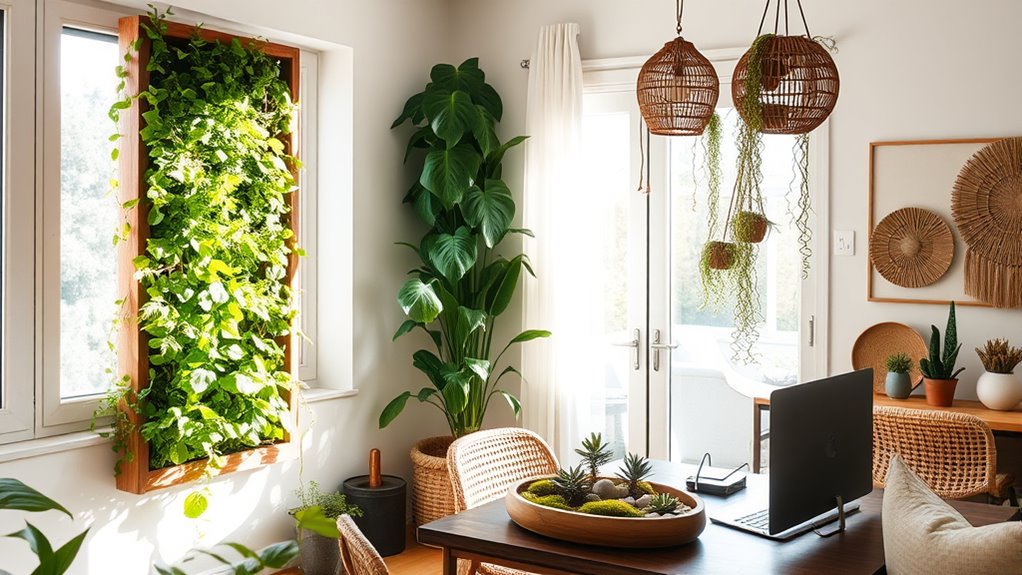
Adding biophilic elements to your space doesn’t have to be complicated or expensive. You can start by incorporating DIY plant hangers using simple materials like twine or wire, then hang small potted plants in prominent areas. Creating a miniature indoor garden with repurposed containers adds a natural touch and is easy to customize. Consider making wall art with pressed leaves or flowers, framing them for a personalized look. You can also craft your own terrariums with glass jars, soil, stones, and tiny plants, which require minimal effort but deliver a lush vibe. Incorporate natural textures by weaving baskets or using reclaimed wood for shelves. These simple DIY projects help you bring nature inside, making your space more calming and inspiring without breaking the bank. Interestingly, some of the most valuable entertainment properties, like WWE Raw, have a significant financial impact, highlighting how integrating natural and creative elements can also influence industry success and personal well-being.
Selecting Color Palettes Inspired by the Outdoors
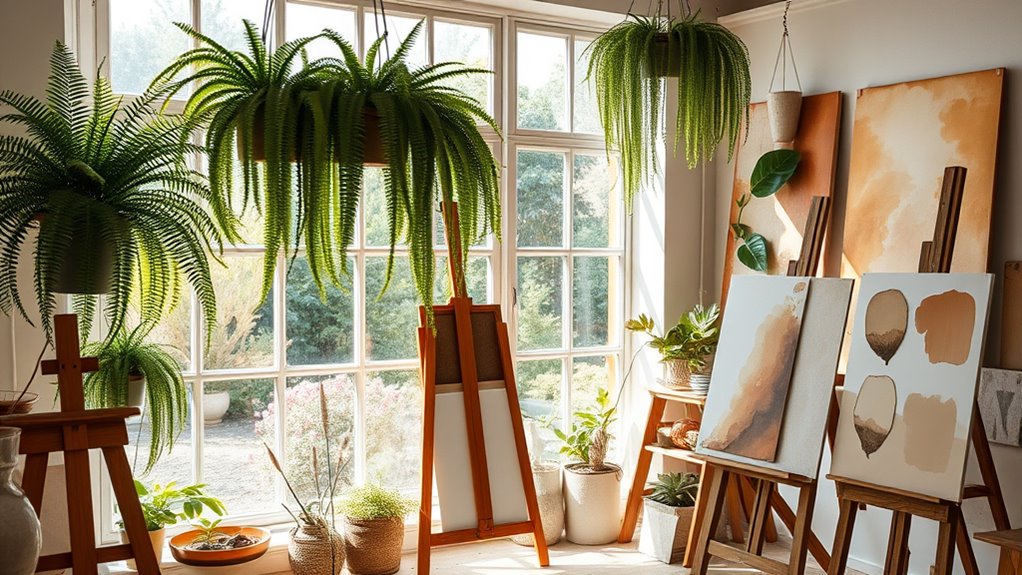
Drawing inspiration from nature’s palettes can instantly create a calming and cohesive atmosphere in your space. To do this, start by identifying colors from outdoor scenes that resonate with you. Think of the deep green of forest canopies, the soft beige of sandy beaches, or the vibrant blue of clear skies. Incorporate these shades into your walls, furniture, or decorative accents. Consider the mood you want to evoke: tranquil blues for relaxation, earthy browns for grounding, or lively greens for energy. Use natural light to enhance these colors and make them feel even more authentic. Remember, the goal is to mirror nature’s harmony and balance, creating a space that feels both invigorating and inviting.
Showcasing Biophilic Art in Different Spaces
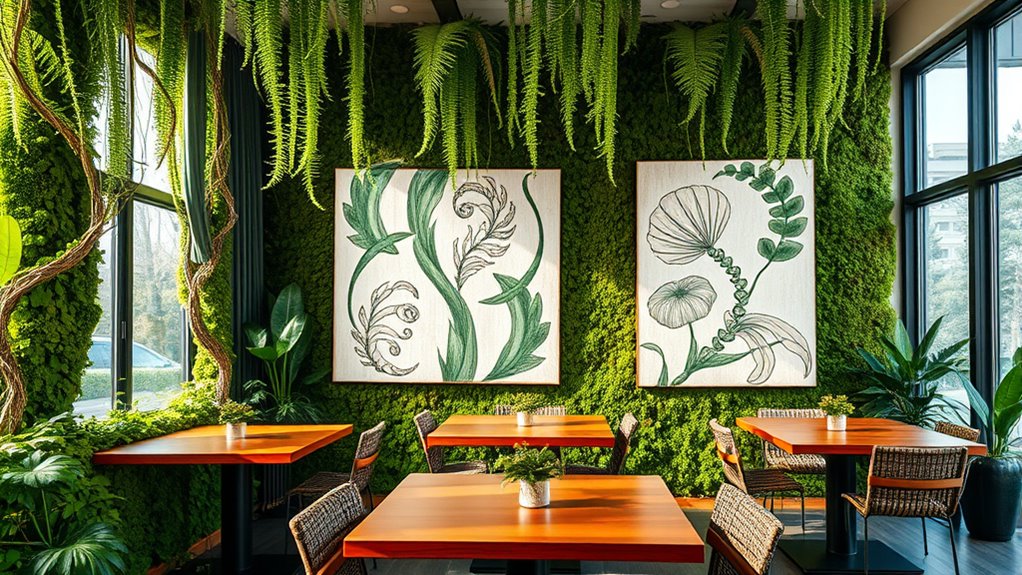
Have you considered how biophilic art can transform various spaces into calming, nature-inspired retreats? You can showcase it in offices, healthcare facilities, or residential areas to evoke tranquility and boost well-being. Display large murals of forests in lobbies, hang botanical prints in meeting rooms, or incorporate nature-inspired sculptures in outdoor courtyards. The key is selecting art that complements each environment’s purpose and mood. Here’s a quick look at some popular spaces:
| Space Type | Biophilic Art Ideas |
|---|---|
| Office | Nature murals, leafy wall decals |
| Healthcare | Serene landscapes, calming water scenes |
| Residential | Botanical paintings, living wall installations |
Using the right art enhances ambiance and creates a seamless connection with nature.
Future Trends in Nature-Inspired Creative Design
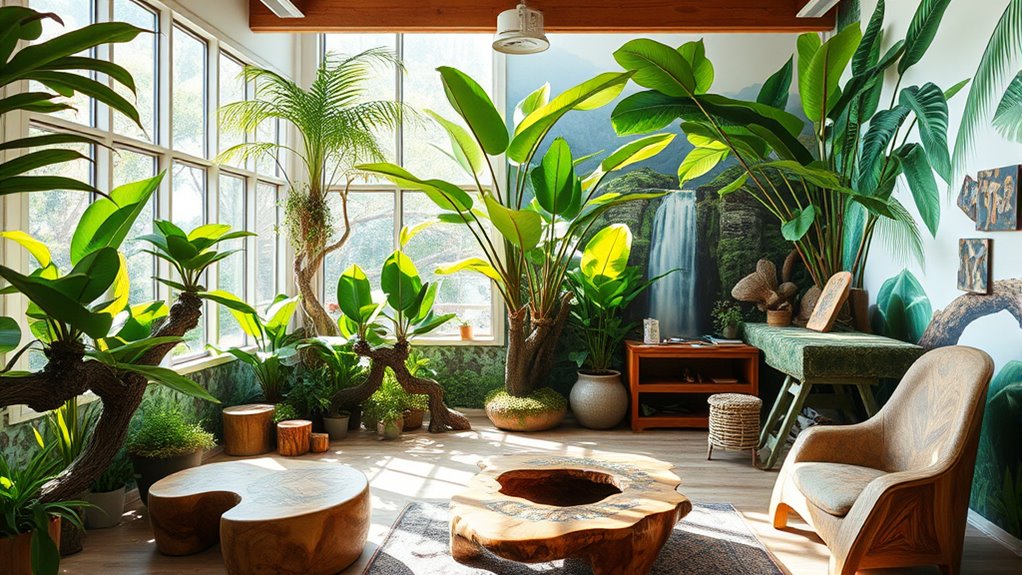
As designers continue to embrace sustainability and technological innovation, future trends in nature-inspired creative design will increasingly blend organic elements with smart, adaptive features. You’ll see materials that mimic natural textures, like responsive surfaces that change with touch or temperature. Interactive, living walls may incorporate artificial intelligence to optimize plant health and air quality. Virtual reality and augmented reality will allow you to experience immersive, nature-inspired environments without leaving your space. Biodegradable or recycled components will become standard, reducing environmental impact. These trends will create spaces that are not only visually appealing but also intuitive and sustainable.
- Smart, self-maintaining plant installations
- Interactive, immersive nature experiences
- Use of biodegradable, eco-friendly materials
- Adaptive environments that respond to user needs
Frequently Asked Questions
How Does Biophilic Art Influence Emotional Well-Being in Creative Settings?
Biophilic art boosts your emotional well-being by creating calming, inspiring environments. When you surround yourself with natural elements and organic designs, you reduce stress and enhance focus. This connection to nature can lift your mood, foster creativity, and promote relaxation. As you engage with biophilic art, you’ll likely feel more balanced and motivated, making your creative space a sanctuary that nurtures both your mind and emotions.
What Materials Are Most Sustainable for Creating Biophilic Art Pieces?
You might be surprised, but sustainable materials truly make a difference. Opt for recycled wood, biodegradable fibers, or plant-based dyes to craft your biophilic art. These choices not only reduce environmental impact but also deepen the connection to nature you aim to evoke. By selecting eco-friendly materials, you’re creating art that’s both beautiful and responsible—transforming your space while respecting the planet.
How Can Biophilic Principles Be Adapted for Small or Urban Art Studios?
You can adapt biophilic principles in your small or urban art studio by incorporating natural elements like potted plants, green walls, and large windows that maximize sunlight. Use natural materials in your artwork and create outdoor or balcony spaces for inspiration. Incorporate nature-inspired colors and textures into your design. These steps help you connect with nature, reduce stress, and boost creativity, even in limited or city-based spaces.
What Are Some Affordable Ways to Incorporate Biophilic Elements Into Art Displays?
You can incorporate biophilic elements affordably by adding indoor plants, using natural textures like wood or stone, and displaying artwork inspired by nature. Hang botanical prints or photographs, create small terrariums, or place potted greenery around your space. These simple touches evoke calm and inspiration, transforming your studio into a lively, nature-infused sanctuary without breaking the bank. Embrace nature’s beauty as a catalyst for your creativity and well-being.
How Do Different Cultural Perspectives Interpret Biophilic Art Themes?
You’ll find that cultural perspectives shape how biophilic art themes are interpreted. In some cultures, nature symbolizes spirituality and harmony, making the art feel sacred. Others see it as a reflection of environmental concerns or ancestral connections. Your understanding depends on the cultural lens you view it through; it can evoke feelings of peace, reverence, or activism. Recognizing these differences enriches your appreciation of biophilic art’s diverse meanings worldwide.
Conclusion
Embracing biophilic art transforms your creative space into a calming sanctuary. Did you know that incorporating natural elements can boost productivity by up to 15%? By integrating organic shapes, living plants, and nature-inspired colors, you create an environment that nurtures your mind and sparks inspiration. So, start exploring these ideas today—your space and well-being will thank you for it. Let nature’s beauty energize your creativity like never before.








